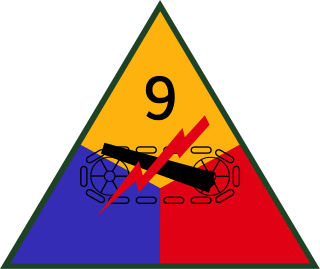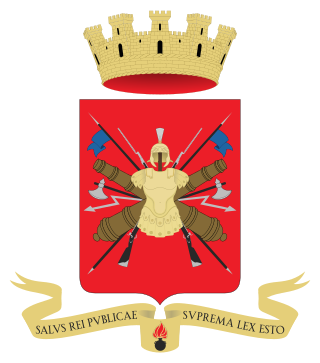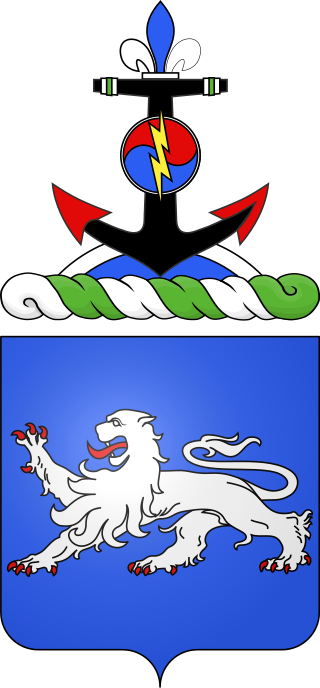Related Research Articles
A division is a large military unit or formation, usually consisting of between 10,000 and 25,000 soldiers. In most armies, a division is composed of several regiments or brigades; in turn, several divisions typically make up a corps.

The 1st Armored Division, nicknamed "Old Ironsides", is a combined arms division of the United States Army. The division is part of III Armored Corps and operates out of Fort Bliss in El Paso, Texas. It was the first armored division of the United States' Army to see battle in World War II. Since World War II, the division has been involved in the Cuban Missile Crisis, Persian Gulf War, Iraq, Afghanistan, and several other operations. The division has also received numerous awards and recognition.

A brigade is a major tactical military formation that typically comprises three to six battalions plus supporting elements. It is roughly equivalent to an enlarged or reinforced regiment. Two or more brigades may constitute a division.

The VII Army Corps of the United States Army was one of the two principal corps of the United States Army Europe during the Cold War. Activated in 1918 for World War I, it was reactivated for World War II and again during the Cold War. During both World War II and the Cold War it was subordinate to the Seventh Army, or USAREUR and was headquartered at Kelley Barracks in Stuttgart, West Germany, from 1951 until it was redeployed to the US after significant success in the Gulf War in 1991, then inactivated in 1992.

The 6th Armored Division was an armored division of the United States Army during World War II. It was formed with a cadre from the 2nd Armored Division.

The 8th Armored Division was an armored division of the United States Army that served in the European Theater of World War II.

The 9th Armored Division was an armored division of the United States Army during World War II. In honor of their World War II service, the 9th was officially nicknamed the "Phantom Division."

The 14th Armored Division was an armored division of the United States Army assigned to the Seventh Army of the Sixth Army Group during World War II. It remains on the permanent roll of the Regular Army as an inactive division, and is eligible for reactivation. The division is officially nicknamed the "Liberators".

The 16th Armored Division was an armored division of the United States Army in World War II. In its one and only combat operation, the 16th Armored Division liberated the city of Plzeň in western Czechoslovakia, an operation that influenced the landscape of post-war Europe.

The Italian Army is the land force branch of the Italian Armed Forces. The army's history dates back to the Italian unification in the 1850s and 1860s. The army fought in colonial engagements in China, Libya, Northern Italy against the Austro-Hungarian Empire during World War I, Abyssinia before World War II and in World War II in Albania, Balkans, North Africa, the Soviet Union, and Italy itself. During the Cold War, the army prepared itself to defend against a Warsaw Pact invasion from the east. Since the end of the Cold War, the army has seen extensive peacekeeping service and combat in Afghanistan and Iraq. Its best-known combat vehicles are the Dardo infantry fighting vehicle, the Centauro tank destroyer and the Ariete tank and among its aircraft the Mangusta attack helicopter, recently deployed in UN missions. The headquarters of the Army General Staff are located in Rome opposite the Quirinal Palace, where the president of Italy resides. The army is an all-volunteer force of active-duty personnel.

The brigade combat team (BCT) is the basic deployable unit of maneuver in the U.S. Army. A brigade combat team consists of one combat arms branch maneuver brigade, and its assigned support and fire units. A brigade is normally commanded by a colonel (O-6) although in some cases a brigadier general (O-7) may assume command. A brigade combat team contains combat support and combat service support units necessary to sustain its operations. BCTs contain organic artillery training and support, received from the parent division artillery (DIVARTY). There are three types of brigade combat teams: infantry, Stryker, and armored.

The 194th Armored Brigade is a separate brigade of the US Army. All armor, cavalry, and armor and cavalry mechanic soldiers, and Marines in equivalent specialties, are trained by the 194th under the armor component of the Maneuver Center of Excellence at Fort Moore, Georgia, where the 194th has been garrisoned since 2012.

The Bulgarian Land Forces are the ground warfare branch of the Bulgarian Armed Forces. It is administered by the Ministry of Defence, previously known as the Ministry of War during the Kingdom of Bulgaria. The Land Forces were established in 1878, when they were composed of anti-Ottoman militia (opalchentsi) and were the only branch of the Bulgarian military.

The 68th Armor Regiment is an armored regiment of the United States Army. It was first activated in 1933 in the Regular Army as the 68th Infantry Regiment.

The 13th Cavalry Regiment is a unit of the United States Army. The 2nd Squadron is currently stationed at Fort Bliss, Texas, as part of the 3rd Armored Brigade Combat Team, 1st Armored Division.

The 34th Armor Regiment is an armored regiment of the United States Army formed in 1941.

The history of the Arkansas Army National Guard and the Cold War involves several statewide re-organizations that occurred as a result of the evolving structure of United States Army Divisions and Brigades. In 1959 the state re-organized and restationed units in response to the Army's adoption of the Pentomic Division, the structure which was designed to counter the Soviet threat in eastern Europe. Several Arkansas National Guard units were mobilized in 1960 as part of the Berlin Crisis. In 1963 the state reorganized again as the administration of President John F. Kennedy focused on "Flexible Response" and divisions reorganized to meet the challenged of numerous small wars such as the war in Vietnam. In 1967 the 39th Infantry Division was reorganized as the 39th Infantry Brigade (Separate) as a result of a plan to reduce the total number of National Guard Divisions nationwide. The state would eventually gain a new headquarters, the State Area Command in order to provide a higher headquarters for several units which were not assigned to either the 142nd Field Artillery Brigade or the 39th Infantry Brigade (Separate).

The 58th Infantry Regiment is a regiment of the United States Army first established in 1917.

After World War II the Italian Army had two units named "Centauro": from 1952 to 1986 the Armored Division "Centauro" and from 1986 to 2002 the Armored Brigade "Centauro". Both units were successor to the World War II era 131st Armored Division "Centauro". The units' name came from the mythological race of half human-half horse creatures named Centaurs.

The Cuban Revolutionary Army serve as the ground forces of Cuba. Formed in 1868 during the Ten Years' War, it was originally known as the Cuban Constitutional Army. Following the Cuban Revolution, the revolutionary military forces was reconstituted as the national army of Cuba by Fidel Castro in 1960. The army is a part of the Cuban Revolutionary Armed Forces which was founded around that time.
References
- ↑ Coffey (2000), p. 42.
- ↑ McGrath (2004), pp. 48–49.
- ↑ Fifth Armoured Division Association (1985), p. 8.
- ↑ Williams, Mary H., ed. (1960). "1945". United States Army in World War II, Special Studies, Chronology 1941–1945. Washington, D.C.: Center Of Military History, United States Army. pp. 365–551.
- ↑ Fifth Armoured Division Association (1985), p. 333.
Sources
- Coffey, Rod A. (2000). Doctrinal Orphan or Active Partner? A History of U.S. Army Mechanized Infantry Doctrine (PDF) (MMAS). Fort Leavenworth, Kansas: U.S. Army Command and General Staff College. Archived (PDF) from the original on May 14, 2021.
- McGrath, John J. (2004). The Brigade: A History, Its Organization and Employment in the US Army. Fort Leavenworth, Kansas: Combat Studies Institute Press.
- Revised Tables of Organization Armored Force. U.S. Army. January 1, 1942.
- Armored Division Tables of Organization. U.S. Army. September 15, 1943.
- "Combined Arms Team in the 20th Century". The Army Historical Foundation. 2007. Archived from the original on September 26, 2007.
- Fifth Armoured Division Association (1985). Paths of Armor: The Fifth Armored Division in World War II. Nashville, Tenn: Battery Press. ISBN 978-0-89839-084-1 – via 5AD Online.